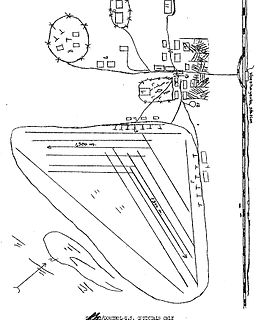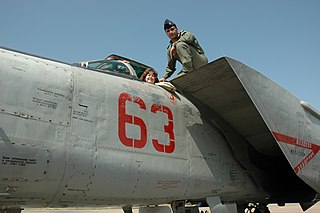
The Air Force and Air Defence, was one of three branches of the Yugoslav People's Army, the Yugoslav military. Commonly referred-to as the Yugoslav Air Force, at its height it was among the largest in Europe. The branch was disbanded in 1992 after the Breakup of Yugoslavia.

The Special Purpose Command was a formation of the Russian Air Force, the strongest among the tactical aviation and anti-aircraft groupings. Its zone of responsibility amounted to 1.3 million km², taking in 40 million people, as well as the country's capital, Moscow. On July 1, 2009 it was superseded by the Aerospace Defense Operational Strategic Command.

Vozzhayevka is an air base in Amur Oblast, Russia located about 100 km southeast of Blagoveshchensk. It is a medium-sized air base located near an SS-11 missile field at Svobodnyy. During the 1980s it was one of 17 airfields hosting the Soviet Union's tactical reconnaissance aircraft regiments.
The 11th Army of VVS and PVO was a formation of the Russian Air Force, which was located in the Russian Far East and Pacific Coast area, and its zone of responsibility covered the Far East Military District.

Nasosnaya Air Base is a military airbase in the municipality of Hacı Zeynalabdin, near the city of Sumqayit in Azerbaijan.

The 83rd Fighter Aviation Regiment was an aviation regiment established in 1944 as 1st Yugoslav Fighter Regiment formed from Yugoslav partisan aviators on training in Soviet Union.
The 763rd Fighter Aviation Regiment was a regiment of the Soviet Air Defence Forces and then the Russian Air Defence Forces from 1952 to 1998.
The 470th Guards Fighter Aviation Regiment was a regiment of the Russian Air Force. It drew much of its traditions and history from the previous 169th Fighter Aviation Regiment and the 63rd Guards Vilensky Order of Kutuzov Fighter Aviation Regiment of the Soviet Air Forces. These two regiments were active during the Second World War and the post-war period.
The 940th Fighter-Bomber Aviation Regiment was an aviation regiment of the Soviet Air Force. It was formed in 1942 in the Soviet Far East and fought in the Soviet invasion of Manchuria. During the last months of the Korean War, the regiment was relocated to China, but did not fight in combat due to the end of the war. After the end of the latter it was transferred to Belarus, where it served for the remainder of the Cold War, being converted into a fighter-bomber regiment in 1960.

Uglovoye,, known in the US intelligence community as Uglovoye Northwest, is an air base in Primorsky Krai located close to the town of Artyom, Russia. This is the primary air defense base for the Vladivostok area, and it was home to the PVO Strany division headquarters for the Vladivostok region
The 105th Guards Borisov-Pomeranian Twice Red Banner Order of Suvorov Mixed Aviation Division is an aviation division of the Russian Air Force, based in Voronezh's Voronezh Malshevo air base.
The 911th Fighter-Bomber Aviation Regiment was an aviation regiment of the Soviet Air Force and later the Belarusian Air Force. It was formed in 1942 in the Soviet Far East as a fighter regiment and fought in the Soviet invasion of Manchuria. After the end of the latter it was stationed in Sakhalin and then the Chukotka Peninsula until 1953, when it moved to Belarus, where it remained for most of the Cold War. In 1960 it was converted into a fighter-bomber aviation regiment. In 1989 it was transferred to East Germany, but withdrawn to Belarus in 1992, where it disbanded in 1993.
The 180th Guards Fighter Aviation Regiment was a military unit of the Red Army Air Force, which took part in the fighting of the Great Patriotic War, and then became part of the Russian Air Defence Forces and finally the Russian Air Force.
The 764th Fighter Aviation Regiment is a regiment of the Russian Air Force, based at Bolshoye Savino Airport near Perm.
The 86th Guards Fighter Aviation Regiment was an aviation regiment of the Soviet Air Forces, and after the dissolution of the Soviet Union, the main formation of the Moldovan Air Force.
The 240th Fighter Aviation Division was a fighter aircraft formation of the Soviet Air Forces during World War II. It saw its most eventful actions during that war, and in 1949 became the 119th Fighter Aviation Division.
The 177th Fighter Aviation Regiment PVO was a fighter regiment of the Soviet Air Defense Forces during World War II and the Cold War, later becoming part of the Russian Air Defense Forces and finally the Russian Air Force.

Blagodatnoye is an abandoned Soviet airbase in Khabarovsk Krai, Russia located 23 km east of Khabarovsk near the town of Kalinka. It was part of the Soviet Air Defence Forces Far Eastern Military District and hosted an interceptor regiment flying Sukhoi Su-9 (Fishpot) and MiG-17 (Fresco) aircraft. It was closed as a military base in 2009.














